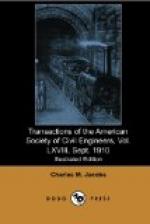[Illustration:
Plate LV.
Material Trestle Over N.Y.C. & H.R.R.R.
Co.’s Tracks;
and Construction of Pier No.
72, North River
Fig. 1.—Material Trestle Over
N.Y.C. & H.R.R.R. Co.’s Tracks.
Fig. 2.—Material Trestle Under
Construction on Pier No. 72,
North River, Showing Clear
Water Over Tunnel Location.
Fig. 3.—Pier No. 72, North
River, Showing Incline as Reconstructed
For Locomotives.]
A length of 150 ft. of the north side of the pier was for the use of the contractor for the North River tunnels; it was equipped with a set of nine chutes similar to those for the south side; they were used but little, and were finally removed to make room for a cableway for unloading sand and crushed stone.
At the foot of the incline there was a bank of eight telphers running on rails securely bolted to the tops of 20-in. I-beams, which were hung from stringers resting on the upper caps. The beams were erected in pairs, each pair being securely braced together and to the trestle posts to prevent swaying. Each telpher occupied the space between two bents, about 10 ft., so that the entire bank commanded a length of 80 ft., which was approximately the length of a rock scow between bulkheads. All supports for the telphers were provided as a part of the trestle, but the machines themselves were a part of the contractor’s plant.
Four derricks were erected on the extension, two on the north and two on the south edge of the pier, supported on bents at a sufficient elevation above the floor to clear a locomotive.
After most of the earth had been excavated, the out-bound set of hoppers on the south side of the pier was removed, and two derricks were erected in their place and used for unloading sand, crushed stone, and other building material.
PLANT.
As the use of the 35th Street pier for the disposal of material required that the mode of transportation should be by dump-wagons drawn by horses, the plant in use by the contractor during that period necessarily differed in many respects from what it was later, when Pier No. 72 was available. Therefore, the nature of the plant during each period will be stated. The plant for each period will be divided into five classes:
1.—Central Plant:
(a) Power-Generating
Plant.
(b) Repair Shops.
2.—Retaining-Wall Plant.
3.—Pit-Excavating Plant.
4.—Transportation Plant.
5.—Dock Plant.
Horse-and-Truck Period: July 11th, 1904, to May 22d, 1905.
1.—Central Plant.




